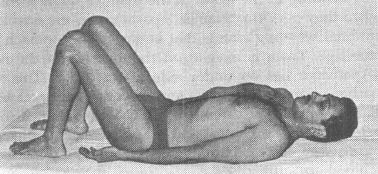Omkar Pranayama
Sitting posture
Sit in any comfortable posture with the spine and head erect. You can keep your hands on the knees in Gyan Mudra posture (join the tips of the index fingers to the tips of the thumbs while keeping the other fingers extended & loose). Close your eyes gently and relax all the muscles.
Technique
1. There is no scientific training necessary for practice of Omkar.
2. Inhale slowly and deeply through the nose.
3. Open the lips and start chanting ���O ���slowly but loudly.
4. Press your lips together and pronounce ���M���.
5. In this pranayama ���O��� or ���AU��� is prolonged and ���M��� or ���UM��� is short.
6. Practice for 5 minutes.
7. Through this pranayama, the brain gets ample blood supply. It���s good for countering stress, tension, allergies, asthma, hypertension, headache and migraine. It improves concentration and memory.
Sivananda pranayama:
Lie down on the mat with face upwards. Bend both the legs from the knees. Keep the distance between the legs the same as the distance between the two shoulders. Keep palms facing upward and a little away from the body. Close eyes.
Technique
Start watching your breath. Breathe in as slowly as possible. Breathe out as slowly as possible. Now begin to deepen your breath consciously. While inhaling, let the abdomen rise to its limit and while exhaling let it fall completely. Notice each breath. Practice 10-15 minutes in the morning, noon, evening as well as late night, whenever your stomach feels light, about three hours after meals.Through this pranayama, we inhale maximum oxygen. It is good for the nervous system, the heart, the digestive system, muscles, energy levels, mental soundness, concentration, memory and much more.
SIVANANDA PRANAYAMA
By performing Sivananda Pranayma, prior to Shavasana and before beginning the practice of other different Pranayamas, the practice of Sivananda Pranayama has proved quite beneficial.
Lie down on the ground with face upwards. Bend both the legs from the knees. Knees should be kept pointing towards the sky and the heels of both the legs should be brought up to the buttocks but not touching them. Keep the distance between the legs same as the distance between the two shoulders. Keep both the hands loose and a little apart from the body and thighs. Keep palms of the hands facing upward. Concentrate the mind on the navel.
Now remain a witness to the respiration being breathed in and out. You must be aware that you are breathing. You must also be aware that you are exhaling. In this manner keep a watch over the respiration so that the breathing in and breathing out do not happen without your knowledge. You must remain happy in this watchfulness. The more that you can maintain this awareness, the more you will have control over your respirations and then you will also be able to control the blood circulation system. Blood pressure also gets controlled. You can practise Sivananda Pranayama m the morning, noon, evening as well as late night, whenever your stomach feels light, about three hours after meals.

Sivananda Pranayama (Fig—30)
Sivananda's Pranayama (Method 2)
Technique: Sit comfortably on a chair, sofa or easy-chair. Draw the air through both nostrils, as long as comfortable. Retain as long as comfortable. Repeat your Ishta Mantra or 'OM' while retaining the breath. Then exhale as long as comfortable. You need not observe any ratio between the inhalation, exhalation and retention; but let the inhalation and exhalation be deep and full.
Benefit: The benefits of this Pranayama are incalculable. All the muscles are relaxed. All the nerves are toned. Rhythm and harmony are established in the entire being. Mind is calmed. Circulation is promoted. An inexpressible peace and bliss come to reign within you.
You can do it in the morning while lying in bed. Your mind will become alert for commencing Japa and Dhyana. You can do it when the mind is about to lose balance on account of the setting in of lust, anger or other evil Vrittis; the mind will be filled with a great power that will prevent the evil Vrittis from disturbing it. You can do it just before commencing your study; the mind will be concentrated easily and what you study will be indelibly impressed in your mind. You can do it during your office-work; you will get new strength every time and you will never be tired. When you return home from the office you can practise this Pranayama and you will be recharged with fresh energy.
The greatest advantage is that once you start doing it you will do it very often; and your mind can never find an excuse for not practising this Ati-Sukha-Purvaka Pranayama, very easy and comfortable Pranayama which has all the advantages of Pranayama, without its 'rules and regulations'. Do it from now without fail.
No comments:
Post a Comment